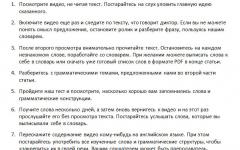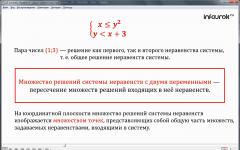What is integration by parts? To master this type of integration, let's first remember the derivative of a product:
$((\left(f\cdot g \right))^(\prime ))=(f)"\cdot g+f\cdot (g)"$
The question arises: what do integrals have to do with it? Now let's integrate both sides of this equation. So let's write it down:
$\int(((\left(f\cdot g \right))^(\prime ))\text(d)x=)\int((f)"\cdot g\,\text(d)x+\ int(f\cdot (g)"\,\text(d)x))$
But what is an antiderivative of a stroke? It's just the function itself, which is inside the stroke. So let's write it down:
$f\cdot g=\int((f)"\cdot g\,\text(d)x+\int(f\cdot (g)"\,\text(d)x))$
In this equation, I propose to express the term. We have:
$\int((f)"\cdot g\,\text(d)x=f\cdot g-\int(f\cdot (g)"\,\text(d)x))$
This is it integration by parts formula. Thus, we are essentially interchanging the derivative and the function. If initially we had an integral of a stroke multiplied by something, then we get an integral of a new something multiplied by a stroke. That's all the rule. At first glance, this formula may seem complicated and meaningless, but in fact, it can greatly simplify calculations. Now let's see.
Examples of integral calculations
Problem 1. Calculate:
\[\int(\ln x\,\text(d)x)\]\[\]
Let's rewrite the expression by adding 1 before the logarithm:
\[\int(\ln x\,\text(d)x)=\int(1\cdot \ln x\,\text(d)x)\]
We have the right to do this because neither the number nor the function will change. Now let's compare this expression with what is written in the formula. The role of $(f)"$ is 1, so we write:
$\begin(align)& (f)"=1\Rightarrow f=x \\& g=\ln x\Rightarrow (g)"=\frac(1)(x) \\\end(align)$
All these functions are in the tables. Now that we have described all the elements that are included in our expression, we will rewrite this integral using the formula for integration by parts:
\[\begin(align)& \int(1\cdot \ln x\,\text(d)x)=x\ln x-\int(x\cdot \frac(1)(x)\text(d )x)=x\ln x-\int(\text(d)x)= \\& =x\ln x-x+C=x\left(\ln x-1 \right)+C \\\ end(align)\]
That's it, the integral has been found.
Problem 2. Calculate:
$\int(x((\text(e))^(-x))\,\text(d)x=\int(x\cdot ((e)^(-x))\,\text(d )x))$
If we take $x$ as the derivative, from which we now need to find the antiderivative, we will get $((x)^(2))$, and the final expression will contain $((x)^(2))( (\text(e))^(-x))$.
Obviously, the problem is not simplified, so we swap the factors under the integral sign:
$\int(x\cdot ((\text(e))^(-x))\,\text(d)x)=\int(((\text(e))^(-x))\cdot x\,\text(d)x)$
Now let’s introduce the notation:
$(f)"=((\text(e))^(-x))\Rightarrow f=\int(((\text(e))^(-x))\,\text(d)x) =-((\text(e))^(-x))$
Let's differentiate $((\text(e))^(-x))$:
$((\left(((\text(e))^(-x)) \right))^(\prime ))=((\text(e))^(-x))\cdot ((\ left(-x \right))^(\prime ))=-((\text(e))^(-x))$
In other words, the minus is added first and then both sides are integrated:
\[\begin(align)& ((\left(((\text(e))^(-x)) \right))^(\prime ))=-((\text(e))^(- x))\Rightarrow ((\text(e))^(-x))=-((\left(((\text(e))^(-x)) \right))^(\prime )) \\& \int(((\text(e))^(-x))\,\text(d)x)=-\int(((\left(((\text(e))^(- x)) \right))^(\prime ))\text(d)x)=-((\text(e))^(-x))+C \\\end(align)\]
Now let's look at the $g$ function:
$g=x\Rightarrow (g)"=1$
We calculate the integral:
$\begin(align)& \int(((\text(e))^(-x))\cdot x\,\text(d)x)=x\cdot \left(-((\text(e ))^(-x)) \right)-\int(\left(-((\text(e))^(-x)) \right)\cdot 1\cdot \text(d)x)= \ \& =-x((\text(e))^(-x))+\int(((\text(e))^(-x))\,\text(d)x)=-x( (\text(e))^(-x))-((\text(e))^(-x))+C=-((\text(e))^(-x))\left(x +1 \right)+C \\\end(align)$
So, we have performed the second integration by parts.
Problem 3. Calculate:
$\int(x\cos 3x\,\text(d)x)$
In this case, what should we take for $(f)"$ and what for $g$? If $x$ acts as a derivative, then during integration we will get $\frac(((x)^(2)))(2 )$, and the first factor will not disappear anywhere - it will be $\frac(((x)^(2)))(2)\cdot \cos 3x$ Therefore, let’s swap the factors again:
$\begin(align)& \int(x\cos 3x\,\text(d)x)=\int(\cos 3x\cdot x\,\text(d)x) \\& (f)"= \cos 3x\Rightarrow f=\int(\cos 3x\,\text(d)x)=\frac(\sin 3x)(3) \\& g=x\Rightarrow (g)"=1 \\\ end(align)$
We rewrite our original expression and expand it according to the integration formula by parts:
\[\begin(align)& \int(\cos 3x\cdot x\ \text(d)x)=\frac(\sin 3x)(3)\cdot x-\int(\frac(\sin 3x) (3)\text(d)x)= \\& =\frac(x\sin 3x)(3)-\frac(1)(3)\int(\sin 3x\,\text(d)x) =\frac(x\sin 3x)(3)+\frac(\cos 3x)(9)+C \\\end(align)\]
That's it, the third problem is solved.
In conclusion, let's take another look at integration by parts formula. How do we choose which factor will be the derivative and which will be the real function? There is only one criterion here: the element that we will differentiate must either give a “beautiful” expression, which will then be reduced, or disappear altogether during differentiation. This concludes the lesson.
Integration by parts. Examples of solutions
Hello again. Today in the lesson we will learn how to integrate by parts. The method of integration by parts is one of the cornerstones of integral calculus. During tests or exams, students are almost always asked to solve the following types of integrals: the simplest integral (see article) or an integral by replacing a variable (see article) or the integral is just on integration by parts method.
As always, you should have on hand: Table of integrals And Derivatives table. If you still don’t have them, then please visit the storage room of my website: Mathematical formulas and tables. I won’t tire of repeating – it’s better to print everything out. I will try to present all the material consistently, simply and clearly; there are no particular difficulties in integrating the parts.
What problem does the method of integration by parts solve? The method of integration by parts solves a very important problem; it allows you to integrate some functions that are not in the table, work functions, and in some cases – even quotients. As we remember, there is no convenient formula: ![]() . But there is this one:
. But there is this one: ![]() – formula for integration by parts in person. I know, I know, you’re the only one - we’ll work with her throughout the lesson (it’s easier now).
– formula for integration by parts in person. I know, I know, you’re the only one - we’ll work with her throughout the lesson (it’s easier now).
And immediately the list to the studio. The integrals of the following types are taken by parts:
1) , ![]() , – logarithm, logarithm multiplied by some polynomial.
, – logarithm, logarithm multiplied by some polynomial.
2) ,![]() is an exponential function multiplied by some polynomial. This also includes integrals like - exponential function, multiplied by a polynomial, but in practice the percentage is 97, there is a nice letter “e” under the integral. ... the article turns out to be somewhat lyrical, oh yes ... spring has come.
is an exponential function multiplied by some polynomial. This also includes integrals like - exponential function, multiplied by a polynomial, but in practice the percentage is 97, there is a nice letter “e” under the integral. ... the article turns out to be somewhat lyrical, oh yes ... spring has come.
3) , ![]() , are trigonometric functions multiplied by some polynomial.
, are trigonometric functions multiplied by some polynomial.
4) , – inverse trigonometric functions (“arches”), “arches” multiplied by some polynomial.
Some fractions are also taken in parts; we will also consider the corresponding examples in detail.
Integrals of logarithms
Example 1
Classic. From time to time this integral can be found in tables, but it is not advisable to use a ready-made answer, since the teacher has spring vitamin deficiency and will swear heavily. Because the integral under consideration is by no means tabular - it is taken in parts. We decide:
We interrupt the solution for intermediate explanations.
We use the integration by parts formula: ![]()
The formula is applied from left to right
We look at the left side: . Obviously, in our example (and in all the others that we will consider) something needs to be designated as , and something as .
In integrals of the type under consideration, the logarithm is always denoted.
Technically, the design of the solution is implemented as follows; we write in the column:
That is, we denoted the logarithm as, and the rest integrand expression.
Next stage: find the differential:

A differential is almost the same as a derivative; we have already discussed how to find it in previous lessons.
Now we find the function. In order to find the function you need to integrate right side lower equality:

Now we open our solution and construct the right side of the formula: .
By the way, here is a sample of the final solution with some notes:

The only point in the work is that I immediately swapped and , since it is customary to write the factor before the logarithm.
As you can see, applying the integration by parts formula essentially reduced our solution to two simple integrals.
Please note that in some cases immediately after application of the formula, a simplification is necessarily carried out under the remaining integral - in the example under consideration, we reduced the integrand to “x”.
Let's check. To do this, you need to take the derivative of the answer:
The original integrand function has been obtained, which means that the integral has been solved correctly.
During the test, we used the product differentiation rule: ![]() . And this is no coincidence.
. And this is no coincidence.
Formula for integration by parts ![]() and formula
and formula ![]() – these are two mutually inverse rules.
– these are two mutually inverse rules.
Example 2
Find indefinite integral.
The integrand is the product of a logarithm and a polynomial.
Let's decide.
![]()
I will once again describe in detail the procedure for applying the rule; in the future, examples will be presented more briefly, and if you have difficulties in solving it on your own, you need to go back to the first two examples of the lesson.
As already mentioned, it is necessary to denote the logarithm (the fact that it is a power does not matter). We denote by the rest integrand expression.
We write in the column:
First we find the differential:

Here we use the differentiation rule complex function ![]() . It is no coincidence that at the very first lesson of the topic Indefinite integral. Examples of solutions I focused on the fact that in order to master integrals, it is necessary to “get your hands on” derivatives. You will have to deal with derivatives more than once.
. It is no coincidence that at the very first lesson of the topic Indefinite integral. Examples of solutions I focused on the fact that in order to master integrals, it is necessary to “get your hands on” derivatives. You will have to deal with derivatives more than once.
Now we find the function, for this we integrate right side lower equality:

For integration we used the simplest tabular formula ![]()
Now everything is ready to apply the formula ![]() . Open with an asterisk and “construct” the solution in accordance with the right side:
. Open with an asterisk and “construct” the solution in accordance with the right side:
Under the integral we again have a polynomial for the logarithm! Therefore, the solution is again interrupted and the rule of integration by parts is applied a second time. Do not forget that in similar situations the logarithm is always denoted.

It would be good if at this moment You were able to find the simplest integrals and derivatives orally.

(1) Don't get confused about the signs! Very often the minus is lost here, also note that the minus refers to to all bracket  , and these brackets need to be expanded correctly.
, and these brackets need to be expanded correctly.
(2) Open the brackets. We simplify the last integral.
(3) We take the last integral.
(4) “Combing” the answer.
The need to apply the rule of integration by parts twice (or even three times) does not arise very rarely.
And now a couple of examples for independent decision:
Example 3
Find the indefinite integral.
This example is solved by changing the variable (or substituting it under the differential sign)! Why not - you can try taking it in parts, it will turn out to be a funny thing.
Example 4
Find the indefinite integral.
But this integral is integrated by parts (the promised fraction).
These are examples for independent solution, solutions and answers at the end of the lesson.
It seems that in examples 3 and 4 the integrands are similar, but the solution methods are different! This is the main difficulty in mastering integrals - if you choose the wrong method for solving an integral, then you can tinker with it for hours, like with a real puzzle. Therefore, the more you solve various integrals, the better, the easier the test and exam will be. In addition, in the second year there will be differential equations, and without experience in solving integrals and derivatives there is nothing to do there.
In terms of logarithms, this is probably more than enough. As an aside, I can also remember that engineering students use logarithms to call female breasts =). By the way, it is useful to know by heart the graphs of the main elementary functions: sine, cosine, arctangent, exponent, polynomials of the third, fourth degree, etc. No, of course, a condom on the globe
I won’t stretch it, but now you will remember a lot from the section Charts and functions =).
Integrals of an exponential multiplied by a polynomial
Example 5
Find the indefinite integral.
![]()
Using a familiar algorithm, we integrate by parts:


If you have difficulties with the integral, then you should return to the article Variable change method in indefinite integral.
The only other thing you can do is tweak the answer:

But if your calculation technique is not very good, then the most profitable option is to leave it as an answer ![]() or even
or even ![]()
That is, the example is considered solved when the last integral is taken. It won’t be a mistake; it’s another matter that the teacher may ask you to simplify the answer.
Example 6
Find the indefinite integral.
This is an example for you to solve on your own. This integral is integrated twice by parts. Particular attention should be paid to the signs - it’s easy to get confused in them, we also remember that this is a complex function.
There is nothing more to say about the exhibitor. I can only add that the exhibitor and natural logarithm reciprocal functions, this is me on the topic of entertaining graphs of higher mathematics =) Stop, stop, don’t worry, the lecturer is sober.
Integrals of trigonometric functions multiplied by a polynomial
General rule: for always denotes a polynomial
Example 7
Find the indefinite integral.
![]()
Let's integrate by parts:


Hmmm...and there is nothing to comment on.
Example 8
Find the indefinite integral ![]()
This is an example for you to solve yourself
Example 9
Find the indefinite integral
Another example with a fraction. As in the two previous examples, for denotes a polynomial.
Let's integrate by parts: 

If you have any difficulties or misunderstandings with finding the integral, I recommend attending the lesson Integrals of trigonometric functions.
Example 10
Find the indefinite integral ![]()
This is an example for you to solve on your own.
Hint: Before using the integration by parts method, you should apply some trigonometric formula, which turns the product of two trigonometric functions into one function. The formula can also be used when applying the method of integration by parts, whichever is more convenient for you.
That's probably all in this paragraph. For some reason I remembered a line from the physics and mathematics hymn “And the sine graph runs wave after wave along the abscissa axis”….
Integrals of inverse trigonometric functions.
Integrals of inverse trigonometric functions multiplied by a polynomial
General rule: always denotes the inverse trigonometric function.
Let me remind you that the inverse trigonometric functions include arcsine, arccosine, arctangent and arccotangent. For the sake of brevity of the record I will call them "arches"
The method of integration by parts is used mainly when the integrand consists of the product of two factors of a certain type. The integration by parts formula looks like:
It makes it possible to reduce the calculation of a given integral  to the calculation of the integral
to the calculation of the integral  , which turns out to be simpler than this one.
, which turns out to be simpler than this one.
Most of the integrals calculated by the method of integration by parts can be divided into three groups:
1. Integrals of the form  ,
, ,
, , Where
, Where  – polynomial,
– polynomial,  – a number not equal to zero
– a number not equal to zero
In this case, through  denote a polynomial
denote a polynomial 
 .
.
2. Integrals of the form  ,
, ,
, ,
, ,
, , Where
, Where  – polynomial.
– polynomial.
In this case, through  denote
denote  , and the rest of the integrand through
, and the rest of the integrand through  :
:
3. Integrals of the form  ,
, , Where
, Where  – numbers.
– numbers.
In this case, through  denote
denote  and apply the integration by parts formula twice, returning as a result to the original integral, after which the original integral is expressed from equality.
and apply the integration by parts formula twice, returning as a result to the original integral, after which the original integral is expressed from equality.
Comment: In some cases, to find a given integral, the integration by parts formula must be applied several times. Also, the method of integration by parts is combined with other methods.
Example 26.
Find integrals using the method by parts: a)  ; b)
; b)  .
.
Solution.
b) 
3.1.4. Integration of Fractional-Rational Functions
Fractional rational function(rational fraction) is a function equal to the ratio of two polynomials:  , Where
, Where  – polynomial of degree
– polynomial of degree  ,
, – polynomial of degree
– polynomial of degree
 .
.
The rational fraction is called correct, if the degree of the polynomial in the numerator is less than the degree of the polynomial in the denominator, i.e.  , otherwise (if
, otherwise (if  ) rational fraction is called wrong.
) rational fraction is called wrong.
Any improper rational fraction can be represented as the sum of a polynomial  and correct rational fraction, dividing the numerator by the denominator according to the rule for dividing polynomials:
and correct rational fraction, dividing the numerator by the denominator according to the rule for dividing polynomials:
 ,
,
Where  – whole part from division,
– whole part from division,  – proper rational fraction,
– proper rational fraction,  – the remainder of the division.
– the remainder of the division.
Proper rational fractions of the form:
I.  ;
;
II.  ;
;
III.  ;
;
IV.  ,
,
Where  ,
, ,
, ,
, ,
, ,
, ,
,
 – real numbers and
– real numbers and  (those. quadratic trinomial in the denominator III and IV of the fractions has no roots - the discriminant is negative) are called simple rational fractions I, II, III and IV types.
(those. quadratic trinomial in the denominator III and IV of the fractions has no roots - the discriminant is negative) are called simple rational fractions I, II, III and IV types.
Integrating simple fractions
Integrals of the simplest fractions of four types are calculated as follows.
I)  .
.
II) ,  .
.
III) For integration simplest fraction Type III, select a complete square in the denominator and replace  . After substitution, the integral is divided into two integrals. The first integral is calculated by isolating the derivative of the denominator in the numerator, which gives a tabular integral, and the second integral is converted to the form
. After substitution, the integral is divided into two integrals. The first integral is calculated by isolating the derivative of the denominator in the numerator, which gives a tabular integral, and the second integral is converted to the form  , because
, because  , which also gives the tabular integral.
, which also gives the tabular integral.


 ;
;
IV) To integrate the simplest fraction of type IV, select a complete square in the denominator and replace  . After substitution, the integral is divided into two integrals. The first integral is calculated by substitution
. After substitution, the integral is divided into two integrals. The first integral is calculated by substitution  , and the second using recurrence relations.
, and the second using recurrence relations.
Example 27.
Find integrals of simple fractions:
A)  ; b)
; b)  ; V)
; V)  .
.
Solution.
A)  .
.
Any proper rational fraction whose denominator can be factorized can be represented as a sum of simple fractions. Decomposition into the sum of simple fractions is carried out using the method of indefinite coefficients. It is as follows:
 corresponds to one fraction of the form
corresponds to one fraction of the form  ;
;
– each factor of the denominator  corresponds to the amount
corresponds to the amount  fractions of the form
fractions of the form
 corresponds to a fraction of the form
corresponds to a fraction of the form  ;
;
– each square factor of the denominator  corresponds to the amount
corresponds to the amount  fractions of the form
fractions of the form
where are the undetermined coefficients.
To find uncertain coefficients, the right side in the form of a sum of simple fractions is brought to a common denominator and transformed. The result is a fraction with the same denominator as on the left side of the equation. Then the denominators are discarded and the numerators are equalized. The result is an identical equality in which the left side is a polynomial with known coefficients, and the right side is a polynomial with unknown coefficients.
There are two ways to determine unknown coefficients: the method of unknown coefficients and the method of partial values.
Method of undetermined coefficients.
Because polynomials are identically equal, then the coefficients at the same powers are equal  . Equating coefficients at the same degrees
. Equating coefficients at the same degrees  in the polynomials of the left and right sides, we obtain the system linear equations. When solving the system, we determine the uncertain coefficients.
in the polynomials of the left and right sides, we obtain the system linear equations. When solving the system, we determine the uncertain coefficients.
Method of private values.
Because polynomials are identically equal, then, substituting  to the left and right sides of any number, we obtain a true equality, linear with respect to the unknown coefficients. Substituting so many values
to the left and right sides of any number, we obtain a true equality, linear with respect to the unknown coefficients. Substituting so many values  , how many unknown coefficients there are, we obtain a system of linear equations. Instead of
, how many unknown coefficients there are, we obtain a system of linear equations. Instead of  You can substitute any numbers into the left and right sides, but it is more convenient to substitute the roots of the denominators of fractions.
You can substitute any numbers into the left and right sides, but it is more convenient to substitute the roots of the denominators of fractions.
After finding the values of the unknown coefficients, the original fraction is written as a sum of simple fractions in the integrand and the previously discussed integration is carried out over each simple fraction.
Integration scheme rational fractions:
1. If the integrand is improper, then it is necessary to present it as the sum of a polynomial and a proper rational fraction (i.e., divide the numerator polynomial by the denominator polynomial with a remainder). If the integrand is correct, we immediately move on to the second point of the diagram.
2. Factor the denominator of a proper rational fraction, if possible.
3. Decompose a proper rational fraction into the sum of simple rational fractions using the method of indefinite coefficients.
4. Integrate the resulting sum of the polynomial and simple fractions.
Example 28.
Find integrals of rational fractions:
A)  ; b)
; b)  ; V)
; V)  .
.
Solution.
A)  .
.
Because the integrand is an improper rational fraction, then we select the whole part, i.e. Let's imagine it as the sum of a polynomial and a proper rational fraction. Divide the polynomial in the numerator by the polynomial in the denominator using a corner.

The original integral will take the form:  .
.
Let us decompose a proper rational fraction into a sum of simple fractions using the method of indefinite coefficients:
 , we get:
, we get:




Solving the system of linear equations, we obtain the values of the uncertain coefficients: A = 1; IN = 3.
Then the required expansion has the form:  .
.
= .
.
b)  .
.
 .
.
Let's discard the denominators and equate the left and right sides:
Equating coefficients at the same degrees  , we get the system:
, we get the system:









By solving a system of five linear equations, we find the undetermined coefficients:
 .
.
Let's find the original integral, taking into account the resulting expansion:

 .
.
V)  .
.
Let us expand the integrand (proper rational fraction) into a sum of simple fractions using the method of indefinite coefficients. We look for decomposition in the form:
 .
.
Reducing to a common denominator, we get:
Let's discard the denominators and equate the left and right sides:
To find uncertain coefficients, we apply the partial value method. Let's add  partial values , at which the factors vanish, i.e., we substitute these values into the last expression and get three equations:
partial values , at which the factors vanish, i.e., we substitute these values into the last expression and get three equations:

 ;
;  ;
;

 ;
;  ;
;

 ;
;  .
.
Then the required expansion has the form:
Let's find the original integral, taking into account the resulting expansion:

We cannot always calculate antiderivative functions, but the differentiation problem can be solved for any function. That is why there is no single integration method that can be used for any type of calculation.
In this material, we will look at examples of solving problems related to finding the indefinite integral, and see what types of integrands each method is suitable for.
Direct integration method
The main method for calculating the antiderivative function is direct integration. This action is based on the properties of the indefinite integral, and for the calculations we need a table of antiderivatives. Other methods can only help bring the original integral to tabular form.
Example 1
Calculate set antiderivative functions f (x) = 2 x + 3 2 5 x + 4 3 .
Solution
First, let's change the form of the function to f (x) = 2 x + 3 2 5 x + 4 3 = 2 x + 3 2 5 x + 4 1 3.
We know that the integral of the sum of functions will be equal to the sum of these integrals, which means:
∫ f (x) d x = ∫ 3 2 5 x + 4 3 = 2 x + 3 2 5 x + 4 1 3 d x = ∫ 3 2 5 x + 4 1 3 d x
We derive the numerical coefficient behind the integral sign:
∫ f (x) d x = ∫ 2 x d x + ∫ 3 2 (5 x + 4) 1 3 d x = = ∫ 2 x d x + 2 3 ∫ (5 x + 4) 1 3 d x
To find the first integral, we will need to refer to the table of antiderivatives. We take from it the value ∫ 2 x d x = 2 x ln 2 + C 1
To find the second integral, you will need a table of antiderivatives for power function∫ x p · d x = x p + 1 p + 1 + C , as well as the rule ∫ f k · x + b d x = 1 k · F (k · x + b) + C .
Therefore, ∫ f (x) d x = ∫ 2 x d x + 3 2 ∫ 5 x + 4 1 3 d x = = 2 x ln 2 + C 1 + 3 2 3 20 (5 x + 4) 4 3 + C 2 = = 2 x ln 2 + 9 40 5 x + 4 4 3 + C
We got the following:
∫ f (x) d x = ∫ 2 x d x + 3 2 ∫ 5 x + 4 1 3 d x = = 2 x ln 2 + C 1 + 3 2 3 20 (5 x + 4) 4 3 + C 2 = = 2 x ln 2 + 9 40 5 x + 4 4 3 + C
with C = C 1 + 3 2 C 2
Answer:∫ f (x) d x = 2 x ln 2 + 9 40 5 x + 4 4 3 + C
We devoted a separate article to direct integration using tables of antiderivatives. We recommend that you familiarize yourself with it.
Substitution method
This method of integration consists in expressing the integrand through a new variable introduced specifically for this purpose. As a result, we should get a tabular form of the integral or simply a less complex integral.
This method is very useful when you need to integrate functions with radicals or trigonometric functions.
Example 2
Evaluate the indefinite integral ∫ 1 x 2 x - 9 d x .
Solution
Let's add one more variable z = 2 x - 9 . Now we need to express x in terms of z:
z 2 = 2 x - 9 ⇒ x = z 2 + 9 2 ⇒ d x = d z 2 + 9 2 = z 2 + 9 2 " d z = 1 2 z d z = z d z
∫ d x x 2 x - 9 = ∫ z d z z 2 + 9 2 · z = 2 ∫ d z z 2 + 9
We take the table of antiderivatives and find out that 2 ∫ d z z 2 + 9 = 2 3 a r c t g z 3 + C .
Now we need to return to the variable x and get the answer:
2 3 a r c t g z 3 + C = 2 3 a r c t g 2 x - 9 3 + C
Answer:∫ 1 x 2 x - 9 d x = 2 3 a r c t g 2 x - 9 3 + C .
If we have to integrate functions with irrationality of the form x m (a + b x n) p, where the values m, n, p are rational numbers, then it is important to correctly compose the expression for introducing a new variable. Read more about this in the article on integrating irrational functions.
As we said above, the substitution method is convenient to use when you need to integrate a trigonometric function. For example, using a universal substitution, you can reduce an expression to a fractionally rational form.
This method explains the integration rule ∫ f (k · x + b) d x = 1 k · F (k · x + b) + C .
We add another variable z = k x + b. We get the following:
x = z k - b k ⇒ d x = d z k - b k = z k - b k " d z = d z k
Now we take the resulting expressions and add them to the integral specified in the condition:
∫ f (k x + b) d x = ∫ f (z) d z k = 1 k ∫ f (z) d z = = 1 k F z + C 1 = F (z) k + C 1 k
If we accept C 1 k = C and return to the original variable x, then we get:
F (z) k + C 1 k = 1 k F k x + b + C
Method of subscribing to the differential sign
This method is based on transforming the integrand into a function of the form f (g (x)) d (g (x)). After this, we perform a substitution by introducing a new variable z = g (x), find an antiderivative for it and return to the original variable.
∫ f (g (x)) d (g (x)) = g (x) = z = ∫ f (z) d (z) = = F (z) + C = z = g (x) = F ( g(x)) + C
To solve problems faster using this method, keep a table of derivatives in the form of differentials and a table of antiderivatives on hand to find the expression to which the integrand will need to be reduced.
Let us analyze a problem in which we need to calculate the set of antiderivatives of the cotangent function.
Example 3
Calculate the indefinite integral ∫ c t g x d x .
Solution
Let's transform the original expression under the integral using basic trigonometric formulas.
c t g x d x = cos s d x sin x
We look at the table of derivatives and see that the numerator can be subsumed under the differential sign cos x d x = d (sin x), which means:
c t g x d x = cos x d x sin x = d sin x sin x, i.e. ∫ c t g x d x = ∫ d sin x sin x .
Let us assume that sin x = z, in this case ∫ d sin x sin x = ∫ d z z. According to the table of antiderivatives, ∫ d z z = ln z + C . Now let's return to the original variable ∫ d z z = ln z + C = ln sin x + C .
All solution in in brief can be written like this:
∫ с t g x d x = ∫ cos x d x sin x = ∫ d sin x sin x = s i n x = t = = ∫ d t t = ln t + C = t = sin x = ln sin x + C
Answer: ∫ c t g x d x = ln sin x + C
The method of subscribing to the differential sign is very often used in practice, so we advise you to read a separate article dedicated to it.
Method of integration by parts
This method is based on transforming the integrand into a product of the form f (x) d x = u (x) v " x d x = u (x) d (v (x)), after which the formula ∫ u (x) d ( v (x)) = u (x) v (x) - ∫ v (x) d u (x) This is a very convenient and common solution method. Sometimes partial integration in one problem has to be applied several times before obtaining the desired result.
Let us analyze a problem in which we need to calculate the set of antiderivatives of the arctangent.
Example 4
Calculate the indefinite integral ∫ a r c t g (2 x) d x .
Solution
Let's assume that u (x) = a r c t g (2 x), d (v (x)) = d x, in this case:
d (u (x)) = u " (x) d x = a r c t g (2 x) " d x = 2 d x 1 + 4 x 2 v (x) = ∫ d (v (x)) = ∫ d x = x
When we calculate the value of the function v (x), we should not add an arbitrary constant C.
∫ a r c t g (2 x) d x = u (x) v (x) - ∫ v (x) d (u (x)) = = x a r c t g (2 x) - ∫ 2 x d x 1 + 4 x 2
We calculate the resulting integral using the method of subsuming the differential sign.
Since ∫ a r c t g (2 x) d x = u (x) v (x) - ∫ v (x) d (u (x)) = x a r c t g (2 x) - ∫ 2 x d x 1 + 4 x 2 , then 2 x d x = 1 4 d (1 + 4 x 2) .
∫ a r c t g (2 x) d x = x · a r c t g (2 x) - ∫ 2 x d x 1 + 4 x 2 = = x · a r c t g (2 x) - 1 4 ln 1 + 4 x 2 + C 1 = = x · a r c t g (2 x) - 1 4 ln 1 + 4 x 2 + C
Answer:∫ a r c t g (2 x) d x = x · a r c t g (2 x) - 1 4 ln 1 + 4 x 2 + C .
The main difficulty in using this method is the need to choose which part to take as the differential and which part as the function u (x). The article on the method of integration by parts provides some advice on this issue that you should familiarize yourself with.
If we need to find the set of antiderivatives of a fractionally rational function, then we must first represent the integrand as a sum of simple fractions, and then integrate the resulting fractions. For more information, see the article on integrating simple fractions.
If we integrate power expression of the form sin 7 x d x or d x (x 2 + a 2) 8 , then they will be useful to us recurrence formulas, which can gradually reduce the degree. They are derived using sequential repeated integration by parts. We recommend reading the article “Integration using recurrence formulas.
Let's summarize. To solve problems, it is very important to know the method of direct integration. Other methods (substitution, substitution, integration by parts) also allow you to simplify the integral and bring it to tabular form.
If you notice an error in the text, please highlight it and press Ctrl+Enter
Let U(x) and V(x) be differentiable functions. Then d(U(x)V(x)) = U(x)dV(x) + V(x)dU(x) . Therefore U(x)dV(x) = d(U(x)V(x)) – V(x)dU(x) . Calculating the integral of both sides of the last equality, taking into account the fact that ∫ d(U(x)V(x))=U(x)V(x)+C, we obtain the relationCalled the integration by parts formula. It is understood in the sense that the set of antiderivatives on the left side coincides with the set of antiderivatives obtained from the right side.
Application of the method of integration by parts
Due to the peculiarities of finding certain quantities, the integration by parts formula is very often used in the following problems:- Mathematical expectation of a continuous random variable. Formula for finding mathematical expectation and the variance of a continuous random variable includes two factors: a polynomial function of x and the distribution density f(x) .
- Fourier series expansion. When decomposing, it is necessary to determine the coefficients, which are found by integrating the product of the function f(x) and the trigonometric function cos(x) or sin(x).
Typical decompositions by parts
When using the integration by parts formula, you need to successfully choose U and dV so that the integral obtained on the right side of the formula is easier to find. Let's put U=e x , dV=xdx in the first example. Then dU=e x dx , and ![]() It is unlikely that the integral ∫ x 2 e x dx can be considered simpler than the original one.
It is unlikely that the integral ∫ x 2 e x dx can be considered simpler than the original one.
Sometimes it is necessary to apply the integration by parts formula several times, for example, when calculating the integral ∫ x 2 sin(x)dx.
The integrals ∫ e ax cos(bx)dx and ∫ e ax sin(bx)dx are called cyclical and are calculated using the integration by parts formula twice.
Example No. 1. Calculate ∫ xe x dx .
Let's put U=x, dV=e x dx. Then dU=dx , V=e x . Therefore ∫ xe x dx=xe x -∫ e x dx=xe x -e x +C .
Example No. 2. Calculate ∫ xcos(x)dx .
We assume U=x, dV=cos(x)dx. Then dU=dx , V=sin(x) and ∫ xcos(x)dx=xsin(x) - ∫ sin(x)dx = xsin(x)+cos(x)+C
Example No. 3. ∫ (3x+4)cos(x)dx
Solution:
Answer: (3x+4)sin(x)+3cos(x)+C








